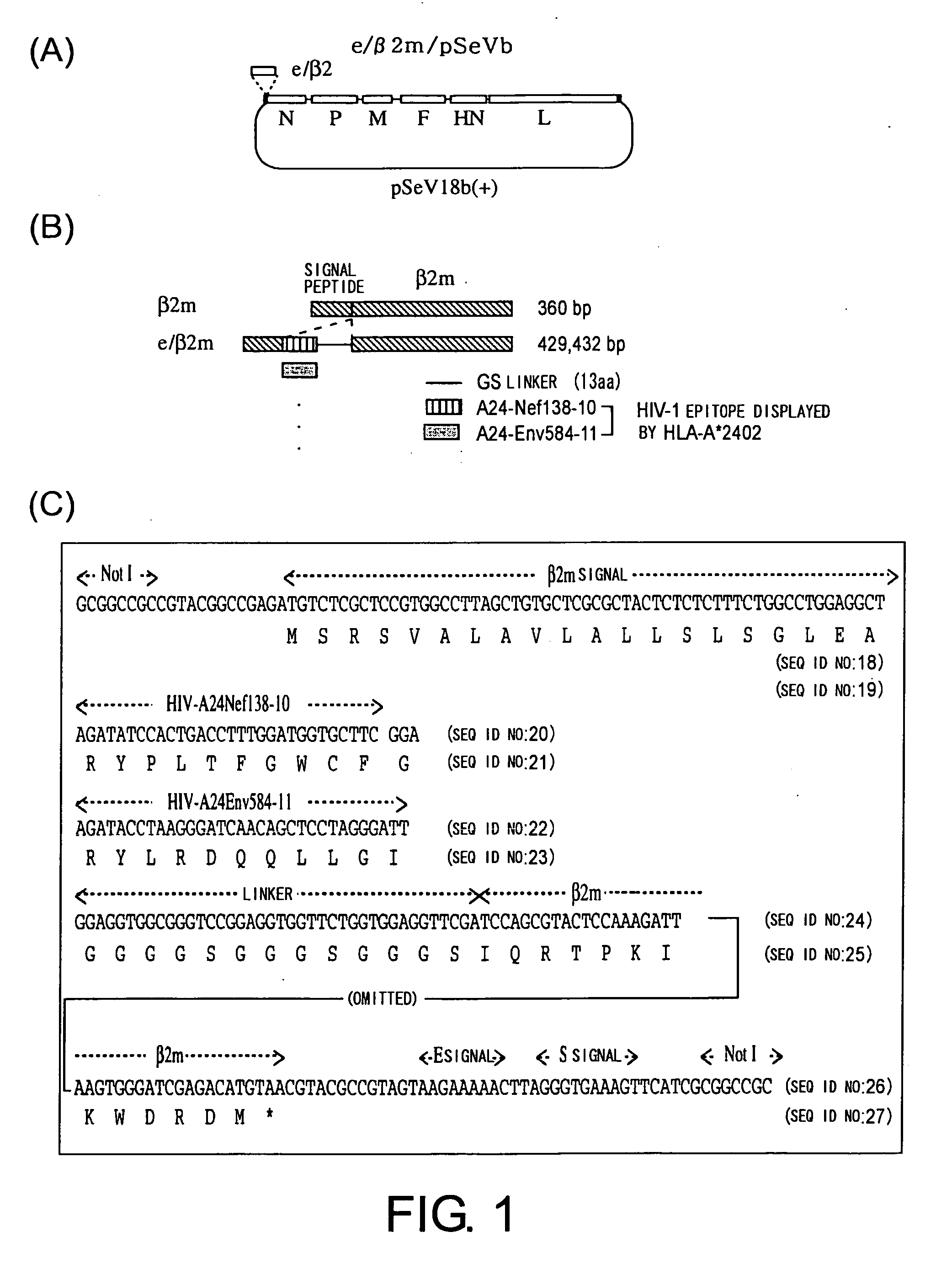Method of strengthening foreign epitope presentation by mhc class i by inhibiting tap activity
a technology of foreign epitopes and mhc class i, which is applied in the direction of peptides, drug compositions, immunological disorders, etc., can solve the problems of low stability, no effect can be expected, and improved stability and antigenicity
- Summary
- Abstract
- Description
- Claims
- Application Information
AI Technical Summary
Benefits of technology
Problems solved by technology
Method used
Image
Examples
example 1
Isolation of the HLA-A*2402 Gene and the Human β2m Gene
[0128] The HLA-A*2402 gene, a human MHC class I gene, and the human β2m gene were cloned from messenger RNAs (mRNA) in peripheral blood mononuclear cells (PBMC) taken from a normal healthy subject carrying the HLA-A24. Micro-FastTrack Kit (Invitrogen) was used for the separation of mRNA and AMV-RT First-strand cDNA synthesis kit (LIFE SCIENCE) was used for the synthesis of cDNA.
[0129] Using the obtained cDNA as a template, PCR was conducted using primer sets HLA-5P2 and HLA-3B, and b2m-5′ and b2m-3′ for the HLA-A*2402 and β2m genes, respectively.
HLA-5P2,(SEQ ID NO: 7)5′-GGGCGGATCCGGACTCAGAATCTCCCCAGACGCCGAG-3′HLA-3B,(SEQ ID NO: 8)5′-CCGCCTCGAGCTGGGGAGGAAACAGGTCAGCATGGGAAC-3′b2m-5′,(SEQ ID NO: 9)5′-GGCACGAGCCGAGATGTCTCGCTCCGTGGC-3′b2m-3′,(SEQ ID NO: 10)5′-AATTTGGAATTCATCCAATCCAAATGCGGC-3′
[0130] PCR was carried out by 35 cycles of 94° C. for 30 sec, 58° C. for 30 sec, and 72° C. for 1 min, followed by extension reaction at 72°...
example 2
Construction of Epitope-Linked-β2m Expression Vector
[0131] The following steps were performed to construct the plasmid (e / β2m / pSeVb) that encodes an SeV vector expressing an epitope-linked-β2m. The insertion of the sequence for each epitope and linkers downstream of the β2m signal sequence, and the attachment of E and S signals of Sendai virus and NotI recognition site were performed by PCR (FIG. 1). The amino acid sequence of the linker (GGGSGGGSGGGS / SEQ ID NO: 11) was designed to have 3 repeated sequences of GGGS (SEQ ID NO: 1). Primers used were as follows:
e / b2m-al,(SEQ ID NO: 12)5′-GGAGGTGGCGGGTCCGGAGGTGGTTCTGGTGGAGGTTCGATCCAGCGTACTCCAAAGATT-3′e(Nef)-a2,(SEQ ID NO: 13)5′-TCTGGCCTGGAGGCTAGATATCCACTGACCTTTGGATGGTGCTTCGGAGGAGGTGGCGGGTCC-3′e(Env)-a2,(SEQ ID NO: 14)5′-TCTGGCCTGGAGGCTAGATACCTAAGGGATCAACAGCTCCTAGGGATTGGAGGTGGCGGGTCC-3′e / b2m-a3,(SEQ ID NO: 15)5′-TGCGGCCGCCGTACGGCCGAGATGTCTCGCTCCGTGGCCTTAGCTGTGCTCGCGCTACTCTCTCTTTCTGGCCTGGAGGCT-3′b2m-d,(SEQ ID NO: 16)5′-TTGCGGCCGCGATGA...
example 3
Construction of Vector Expressing a Membrane-Bound Form of an MHC class I Heavy Chain
[0133] The addition of the E and S signals of Sendai virus and the NotI site was performed by PCR (FIG. 2).
[0134] Primers used were as follows:
A24-a#,(SEQ ID NO: 28)5′-TGCGGCCGCCGTACGCCGAGGATGGCCGTCATGGCGCCCCG-3′A24-d4,(SEQ ID NO: 29)5′-TTGCGGCCGCGATGAACTTTCACCCTAAGTTTTTCTTACTACGGCGTACGTCACACTTTACAAGCTGTGAG-3′
[0135] PCR was carried out using A*2402 / pGEM as a template and a set of primers A24-a# and A24-d4 by 15 cycles of 94° C. for 1 min, 48° C. for 1 min, and 72° C. for 1 min, followed by an extension reaction at 72° C. for 7 min, yielding A24 μl fragment. A24full / pSeVb was obtained similarly to the generation of e / β2m / pSeVb.
PUM
| Property | Measurement | Unit |
|---|---|---|
| Frequency | aaaaa | aaaaa |
| Inhibition | aaaaa | aaaaa |
Abstract
Description
Claims
Application Information
 Login to View More
Login to View More - R&D
- Intellectual Property
- Life Sciences
- Materials
- Tech Scout
- Unparalleled Data Quality
- Higher Quality Content
- 60% Fewer Hallucinations
Browse by: Latest US Patents, China's latest patents, Technical Efficacy Thesaurus, Application Domain, Technology Topic, Popular Technical Reports.
© 2025 PatSnap. All rights reserved.Legal|Privacy policy|Modern Slavery Act Transparency Statement|Sitemap|About US| Contact US: help@patsnap.com



